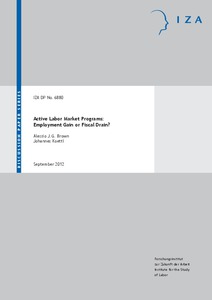Active labor market programs: employment gain or fiscal drain?
"This paper provides a new perspective by classifying active labor market programs (ALMPs) depending on their main objectives and their relevance and cost-effectiveness during normal times, during a crisis, and during recovery. We distinguish ALMPs that provide: (i) incentives for retaining emp...
| Main Authors: | , |
|---|---|
| Institution: | ETUI-European Trade Union Institute |
| Format: | TEXT |
| Language: | English |
| Published: |
Bonn
2012
IZA |
| Subjects: | |
| Online Access: | https://www.labourline.org/KENTIKA-19132074124919502569-active-labor-market-programs-e.htm |
| Summary: | "This paper provides a new perspective by classifying active labor market programs (ALMPs) depending on their main objectives and their relevance and cost-effectiveness during normal times, during a crisis, and during recovery. We distinguish ALMPs that provide: (i) incentives for retaining employment, (ii) incentives for creating employment, (iii) incentives for seeking and keeping a job, (iv) incentives for human capital enhancement, and (v) improved labor market matching. Reviewing evidence from the literature, we discuss direct and indirect effects of various interventions, their cost-effectiveness, and draw lessons for transition and developing countries. The paper concludes by providing a systematic overview of how, why, when and to what extent specific ALMPs are effective. In particular, the paper shows that ALMPs retaining employment, like work sharing schemes, should be applied in severe recessions for a limited time period of time only. ALMPs creating employment, like hiring subsidies, perform much better on cost-effectiveness and strengthen the outsiders' position in the labor market, especially during recoveries. In-work benefits and public works are not very cost-efficient in terms of raising employment, but might be cost-efficient in reducing poverty and inequity. Policies readjusting distorted employment incentives, such as activation and sanction measures, have proven to provide cost-effective results during normal times." |
|---|---|
| Physical Description: | 45 p. Digital |

